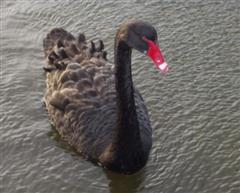Swan - Australian Black Swan
Scientific Name: Cygnus atratus
Mon, 28th April, 2025 - 10:21 pm GMT
Sponsor Ads:

Alternative Name
Scientific Name: Cygnus atratusBasic Info
As their name would suggest, the plumage of the Black Swan is usually entirely black. They have red eyes and bills, although the bill usually has a white band at the end. Black Swan's feathers usually curl. The primaries (one of the types of feathers) are usually white, but they are only visible when the swan is flying. Black Swans are large birds, averaging as much as five feet in length.
Health
The diet of the Black Swan consists of roots, plants that grow in the fresh water they live in and even sometimes, they will eat small fish. Breeding Black Swans mate for life and both sexes help in taking care of their young. They both help with building the nest and the male is very adamant at protecting it. The female will eat more than she normally does before she nests and lays up to 10 eggs that incubate for almost five weeks. The young will go into the water with their parents almost immediately after hatching. They remain a family unit for sometime, with the young attaining adulthood around two years of age.Habitat
Found in the wild in both New Zealand and SwedenBehavior
The Australian Black Swan is, as the name would suggest, native to Australia. They are very common in captivity and are very social animals. The Black Swan is a beautiful addition to any pond. Ducking its head and beak into the water, the Black Swan pulls up the vegetation that makes up the majority of its diet. Black Swans will also feed on seeds and roots it finds on the edge of the water or, from time to time, on small frogs or fish. The Black Swan generally can be found in a large flock. They are monogamous animals, meaning they mate for life, and in breeding season the pairs often break off from the flock and can be aggressive towards other pairs that approach their nests. The Black Swan is so social that, unlike other swans that will never nest in groups, they will sometimes form small colonies of nesting pairs. Although Black Swans are capable of flight, they often have difficulty getting off the ground because of their large size. They require a long running start before they can take off. Once airborne, however, they are among the smallest fliers in the world of aquatic ducks. Unfortunately, their strong flying skills are not coupled with equal skill in maneuvering so they often collide midair. In fact, most Black Swan fatalities that are not caused by man are caused by airborne collisions.Origin
Scientific Name: Cygnus atratusHistory
One of the most common swans in captivity, and the only breed seen in zoos more often then the Black Swan is the Mute Swan. Black Swans are found throughout Australia and Tasmania and are often kept by private owners, zoos and city parks. Beyond Australia and Tasmania, the Black Swan can be found in the wild in both New Zealand and Sweden. These populations are not native and were introduced instead.Common Foods
N/ASponsor Ads:
Any component, when inadvertently dropped, will roll into a hiding place, the inaccessibility of which is proportional to the square of the component's irreplaceability. -- Unknown
Swan - Australian Black Swan
Coded by: BGID® | ALL RIGHTS RESERVED Copyright © 2000-2025
Disclaimer | Privacy | Report Errors / Contact | Credits








 Why haven't we as a collective earth met with aliens yet?
Why haven't we as a collective earth met with aliens yet?  The Best Text Adventure You Will Ever Play! The official site:
The Best Text Adventure You Will Ever Play! The official site:  Homosexual behavior stems from the mind or genetics?
Homosexual behavior stems from the mind or genetics?  World EcoSystem - Biodiversity Changes - Who is on board and who isn
World EcoSystem - Biodiversity Changes - Who is on board and who isn  Mouthwash - Mouthrinse - Mouth Sores - Healing Infections - Gingivitis
Mouthwash - Mouthrinse - Mouth Sores - Healing Infections - Gingivitis  Treatment for Depression
Treatment for Depression  Ultra radical and violent Islamist group that even rivals Al Qaeda
Ultra radical and violent Islamist group that even rivals Al Qaeda  An idea to have teachers who want to carry guns to school undergo some level of police training will be left up to local school districts and police departments.
An idea to have teachers who want to carry guns to school undergo some level of police training will be left up to local school districts and police departments.